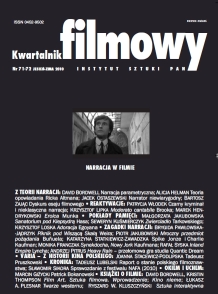Czarny kryminał i nieklasyczna narracja. "Wielki sen" Howarda Hawksa, "Żegnaj Laleczko" Edwarda Dmytryka i "Tajemnica jeziora" Roberta Montgomery’ego
Film noir and non-classical narration. Howard Hawks' "The Big Sleep", Edward Dmytryk's "Murder, My Sweet" and Robert Montgomery's "Lady in the Lake"
Author(s): Patrycja WłodekSubject(s): Theatre, Dance, Performing Arts
Published by: Instytut Sztuki Polskiej Akademii Nauk
Keywords: Film Noir
Summary/Abstract: Film Noir, one of the most popular genres in the 1940s Hollywood, offered not only a certain aesthetics, expressionist style of filming, the private detective character and the demonic femme fatale, but also explored alternative forms of film narration. The makers of those films, by applying first person narrative or its equivalent, were not only true to the hard-boiled fiction novels they adapted for screen, but also appreciated the inadequacy of linear classic narration to the mood in the USA during the Second World War and afterwards. Three different film adaptations of Raymond Chandler’s crime novels, that is Edward Dmytryk’s "Murder, My Sweet" (1944), Robert Montgomery’s "Lady in the Lake" (1945), and Howard Hawks’ "The Big Sleep" (1946), brought three different strategies of narration – separate sequences representing the mental state of the lead character, free dependent narrative, where the main character is present in every frame, and shooting almost every scene with so called subjective camera. At the same time the experiments were restricted by the conservative attitudes present in Hollywood and self-censorship, revealing an interesting struggle between innovation and tradition.
Journal: Kwartalnik Filmowy
- Issue Year: 2010
- Issue No: 71-72
- Page Range: 98-110
- Page Count: 13
- Language: Polish

